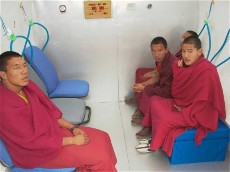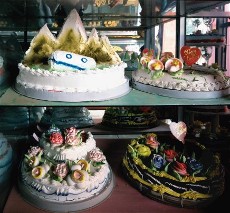
Although I was heading off to help my son move, I also scheduled in a little art. Chelsea was practically deserted, most galleries closed, either for vacation or for the changeover to September shows. I had checked the hours of every single gallery web site I had on my list. Nonetheless, a number turned out to be closed. I take this as proof that telephones have not yet lost their usefulness. The website untruths were the beginning of trip that turned out to be very much about reality and where it resided.
My first stop was at the New Museum. I wanted to see Patty Chang’s video, “Shangri-la,” of her visit to the Chinese city that, eager for tourist dollars, claims it is the Shangri-la of “Lost Horizon,” by James Hilton. Two other cities staked a similar claim, but the Chinese government decided the first claimant was the real thing. So much for reality.
Chang’s film is called “Shangri-la.” It’s about what’s real (image of monks entering a pressure pod set built by Chang in an old-fashioned Chinese courtyard). It’s also about a search for some idealized place, which I take to be what drew Chang to China in the first place.
The video is 40 minutes long, so I sat and I sat and I sat and I sat, taking in the air conditioning as well as the imagery. Although the editing is a little confusing because time and place seemed to flick back and forth, I somehow didn’t mind. There’s a deliberate crudeness to Chang’s work, and the funky editing was a good fit to the whole project.
This video is a sort of “Road to Shangri-La” movie, its opener showing the view from the plane flying above the clouds and mountain peaks. All we lack is Bing and Bob.

Near the start of the movie this group of monks climb up a steep, rocky path (some wearing sneakers). Then the camera pulls back and you see this is no mountainside, but rather a man-made rocky wall in a large hotel atrium.
Then the same group of monks (are they really monks?) enter a faux pressure chamber movie set located in an old-fashioned Chinese courtyard (see top image).
And here they are sitting in the pressure pod. While the monks sit in the pressure pod, sometimes with faux oxygen masks on their faces, one monk starts caressing another monk’s ankle. I find myself wondering if this is acceptable monk behavior. I truly do not know the answer to this question.
The pod serves also as a kind of airplane substitute, and it makes clear that in many ways this is a trip of the mind and the imagination. It is also a substitute lamasary, the place described in “Lost Horizon.” It also raises issues of altitude sickness. But the monks are the ones used to the rarefied air, unlike the video makers.
Here on the left side of the top shelf is what I took to be the wedding cake for Chang’s faux wedding, also part of the film. She asks the bakers to reproduce her picture of the mountains as a sculpture atop the cake. The pressure chamber is also on the cake in front of the mountains. The bakers and cake decorators seemed less than pleased with the decorations they were making. The flowered cakes are part of their usual output. I loved watching the mountains being piled up, then iced, then corrected, then re-iced. There are conflicting ideals here.

In a parallel kind of process with a parallel kind of crude product, Chang also had Chinese craftsmen make this mirrored version of the same mountain. Here is Chang’s funky mountain on the road, being moved to the real mountains on a pickup truck. Chang also had a styrofoam version of this mountain created a little earlier in the video. But the mirror is a nice reminder of how art is the reflection of its maker and of the world around it. The movie really hits its stride in this on-the-road sequence.
The mirror mountain is also on display on the back of a pickup truck in the New Museum. It has only a frontal orientation. The back is open and wood and plywood.
There’s also something weird going on in the attempt to make the skilled craftsmen follow directions that clearly subvert their skills and how they see things. What results is their interpretation of Chang’s vision of what she wants. Something similar goes on when she poses in a wedding dress with a tuxedoed groom as wedding photographers tell the two how to position themselves for the standard photos. I was reminded here of Liz Rywelski turning herself over to Olan Mills photographers and K-Mart sales girls (see Brent Burket’s post).
Even though I think Chang is asking too much of her viewers in the haphazard editing and sequencing, she nails the issues she is raising about culture, expectations, beauty, conventions and reality, and I’d sit through it all over again.









